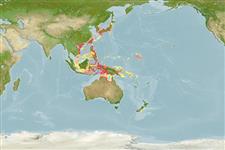>
Gobiiformes (Gobies) >
Gobiidae (Gobies) > Gobiinae
Eponymy: Keinosuke Otaki (d: 1911) was Professor of English at the Imperial Military Academy of Tokyo for a decade, and a former zoology graduate (1894) student at Stanford University (where Jordan was president). [...] (Ref. 128868), visit book page.
More on authors: Jordan & Snyder.
Environment: milieu / climate zone / distribuzione batimetrica / distribution range
Ecologia
marino demersale; distribuzione batimetrica 20 - 35 m (Ref. 559). Temperate
Western Pacific: Japan, Taiwan, Philippines and Indonesia.
Size / Peso / Age
Maturità: Lm ? range ? - ? cm
Max length : 6.5 cm TL maschio/sesso non determinato; (Ref. 90102)
Short description
Chiavi di identificazione | Morfologia | Morfometria
Spine dorsali (totale) : 6 - 7; Raggi dorsali molli (totale) : 10; Spine anali: 1; Raggi anali molli: 10. Characterized by pale greyish brown with blackish blotch at upper rear margin of gill cover, longitudinal row of five, horizontally ovate to rectangular blackish blotches with smaller white spots between on side at level of pectoral fin base, first below spinous dorsal fin and last at midbase of caudal fin; back with about five diffuse saddles and numerous dark brown to blackish spots; white streak on middle of pectoral fin; first dorsal spine of each fin and sharp; fully united pelvic fins, frenum present; rounded caudal fin; longitudinal scale series 27; predorsal scales 7-8; ctenoid scales on body, becoming cycloid on head, pectoral fin base and prepelvic area; fully scaled cheek and opercle; depth of body 4.5-6.2 in SL (Ref. 90102).
Body shape (shape guide): elongated.
Inhabits sand and rubble bottoms (Ref. 90102).
Life cycle and mating behavior
Maturità | Riproduzione | Deposizione | Uova | Fecundity | Larve
Masuda, H., K. Amaoka, C. Araga, T. Uyeno and T. Yoshino, 1984. The fishes of the Japanese Archipelago. Vol. 1. Tokai University Press, Tokyo, Japan. 437 p. (text). (Ref. 559)
IUCN Red List Status (Ref. 130435: Version 2025-1)
Threat to humans
Harmless
Human uses
Pesca: di potenziale interesse
Strumenti
Special reports
Download XML
Fonti Internet
Estimates based on models
Preferred temperature (Fonte Biblio.
123201): 17.6 - 28.5, mean 27 °C (based on 27 cells).
Phylogenetic diversity index (Fonte Biblio.
82804): PD
50 = 0.5078 [Uniqueness, from 0.5 = low to 2.0 = high].
Bayesian length-weight: a=0.00724 (0.00339 - 0.01546), b=3.10 (2.92 - 3.28), in cm total length, based on LWR estimates for this (Sub)family-body shape (Ref.
93245).
Trophic level (Fonte Biblio.
69278): 3.2 ±0.3 se; based on size and trophs of closest relatives
Resilienza (Fonte Biblio.
120179): Alto, tempo minimo di raddoppiamento della popolazione meno di 15 mesi (Preliminary K or Fecundity.).
Fishing Vulnerability (Ref.
59153): Low vulnerability (10 of 100).
🛈
